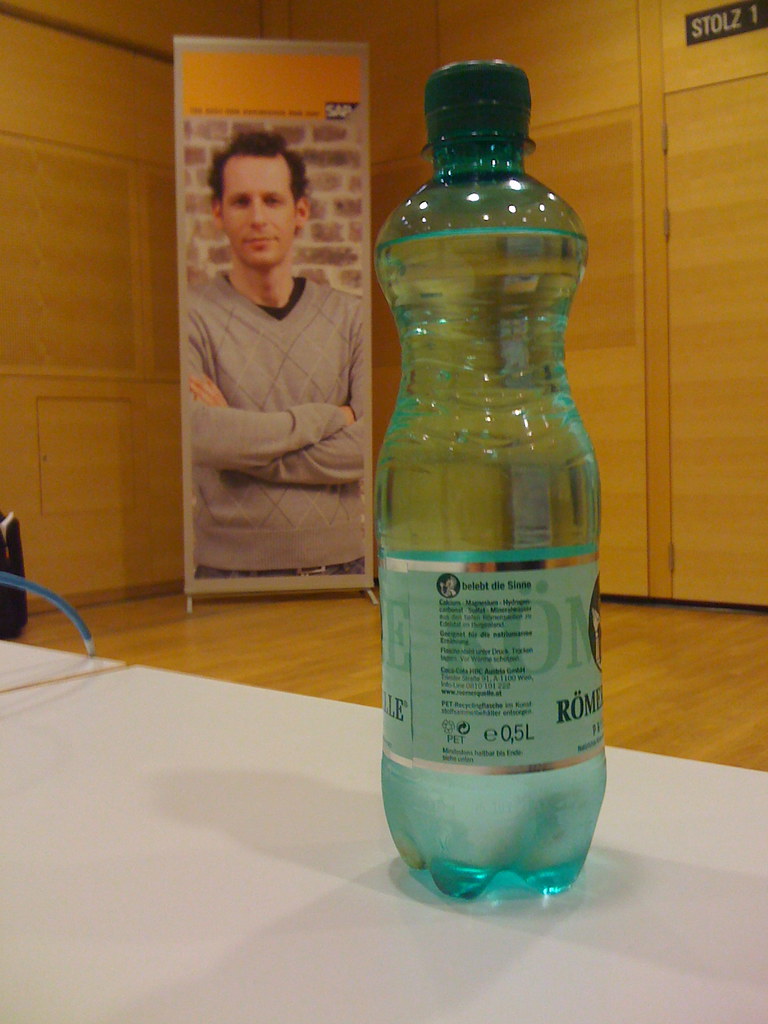I attend a lot of conferences.
The two most recent ones I was at were both run by SAP. The first was the International SAP for Utilities conference in Munich, the second was the SAP TechEd conference in Vienna. Both events were very interesting for a variety of reasons but both conferences left a nasty (dry) taste in my mouth because the only water available to drink was bottled water!
What is the big deal about using bottled water, you ask?
Well, according to Food and Water Watch:
Bottled water wastes fossil fuels and water in production and transport, and when the water is drunk the bottles become a major source of waste. It takes more than 47 million gallons of oil to produce plastic water bottles for Americans every year. Eliminating those bottles would be like taking 100,000 cars off the road and 1 billion pounds of carbon dioxide out of the atmosphere. Each one of those bottles required nearly five times its volume in water to manufacture the plastic and may have caused the release of nickel, ethylene oxide, and benzene. Then, rather than being recycled, 86 percent of them are thrown away. Breaking down these plastics can take thousands of years, while their components seep into our water supplies.
And don’t just take their word for it, check out the NRDC’s page on bottled water. See also Lighterfootstep.com’s 5 Reasons not to drink Bottled Water and even Wikipedia’s entry on bottled water vs tap water, which tells us amongst other things that:
In the United States, bottled water costs between $0.25 and $2 per bottle while tap water costs less than US$0.01. In 1999, according to a NRDC study, U.S. consumers paid between 240 and 10,000 times more per unit volume for bottled water than for tap water. According to Bottledwaterblues.com, about 90% of manufacturer’s costs is from making the bottle, label, and cap.
What’s worse, a significant proportion of bottled water is simply tap water which has been bottled! No, really. Both Aquafina from PepsiCo and Dasani from The Coca-Cola Company originate from municipal water systems, for example!
Despite all that, an estimated 50 billion bottles of water are consumed per annum in the US and around 200 billion bottles globally.
Come on SAP. You are working hard on improving your sustainability message. And by and large are doing a good job at it but really, bottled water? In 2009?
Here’s my challenge to SAP (and all conference organisers) – make commitment that you will never again run a conference at a venue that can’t provide water dispensing machines, instead of bottled water.
Seriously, if you are negotiating with a venue about holding your event and you mention that that is a dealbreaker, they’ll provide the machines.


Tom – you are right. Bottled water should have no place on the menu in this day and age.
Lets not forget the elephant in the living room here though – air travel. A typical delegate flying roundtrip within Europe would have to drink around 2500 bottles of water to match the damage done to climate by flying there.
Hey James,
thanks for stopping by and commenting on this.
You are absolutely correct to point out that the air travel by delegates has a much higher carbon footprint than the bottles. However, you need to remember that bottled water does much more damage than just the CO2 emitted in its production and transportation. There is also the environmental damage from the PET bottles themselves, not to mention the detrimental effects on our health of drinking from these bottles.
Also consider that most delegates didn’t have a choice of how they travelled to the venue. Had there been water dispensers available, they would, at least, have had a choice not to damage the environment by merely having a drink.
T0m
I agree … more to bottles than CO2.
However, I disagree that conference delegates, whatever the event, in general have no choices to make when it comes to travel. First, delegates can increasingly choose virtual options and avoid the travel completely and we should encourage the professional conference business to develop these options and enhance the virtual experience.
Next, people can be creative and choose taking train transport where possible. Its more viable than you think. I’m planning a trip to London next week and I am going to try to take the train. I found it takes only 90 minutes longer door to door and I can keep working and be more productive enroute.
Finally, it is possible and important to consider which carriers operate more efficiently when we do have to fly. Real information in this regard is becoming more available in the market place and as consumers we should demand it.